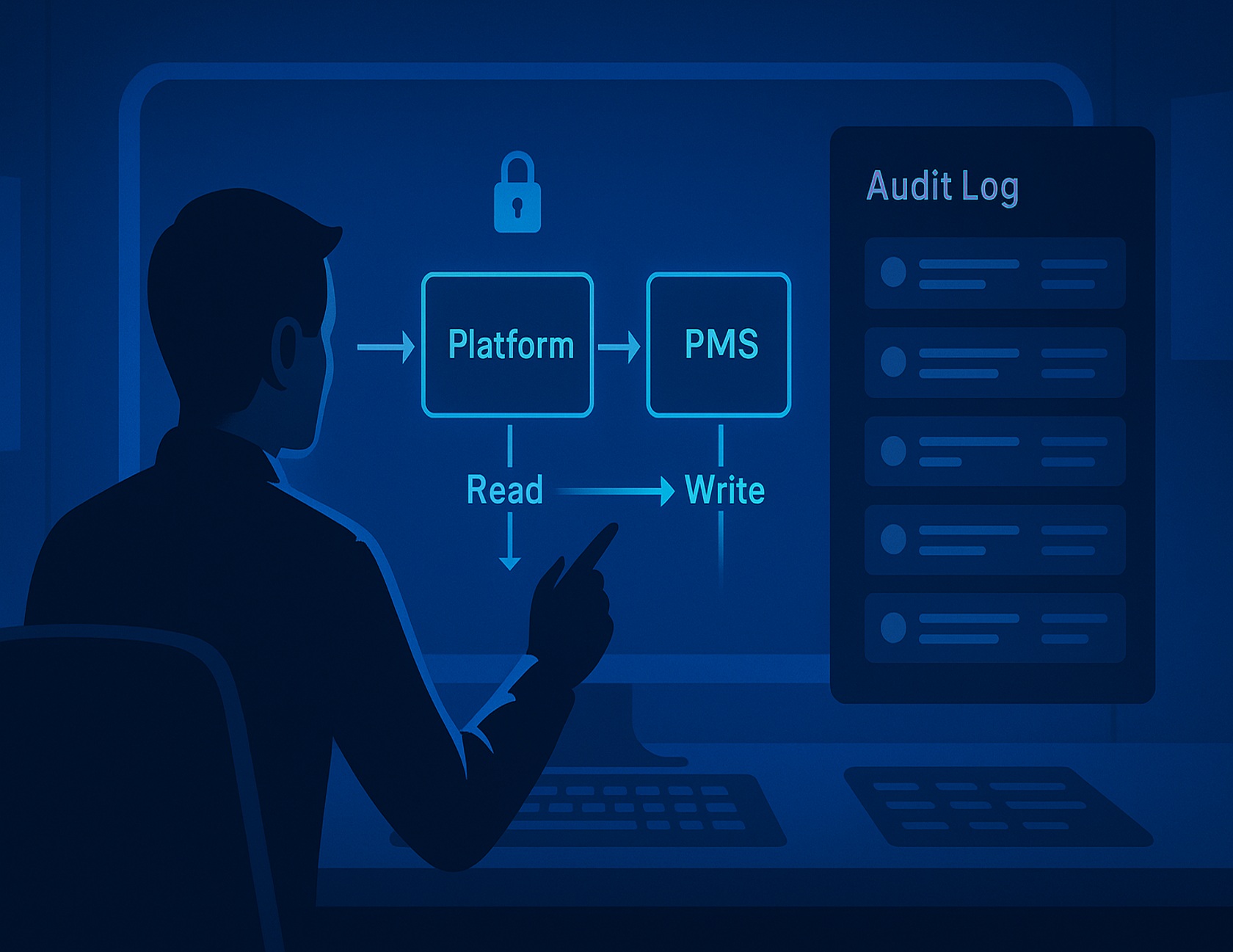
📌 Key Takeaways
The difference between a successful pilot and portfolio chaos lies in locking standards before scaling begins.
Lock Your Standards First: Define SLA taxonomy, response thresholds, and reporting dimensions during the pilot phase—before adding a single additional property.
Institute Formal Change Control: Create approval matrices and versioning systems that prevent well-meaning teams from making "minor adjustments" that destroy consistency across sites.
Scale in Controlled Waves: Group properties into manageable deployment phases with readiness criteria, training periods, and early variance detection to prevent operational shock.
Measure What Matters: Track SLA adherence percentages, escalation rates, and variance trends through portfolio KPIs that validate systematic value beyond pilot success stories.
Build Governance That Sustains: Establish standing committees with clear ownership boundaries between day-to-day site management and centralized standard maintenance.
Standards without enforcement become suggestions; enforcement without measurement becomes chaos.
For Class A multifamily community managers and their IT partners managing resident experience platforms across multiple properties, these frameworks prevent the service degradation that typically accompanies rapid scaling.
The stakes rise after a smooth single-building pilot. Standards wobble, dashboards diverge, and weekend pages spike. Calm operations require a repeatable way to lock what worked and scale it across the portfolio—without losing the resident experience that made the pilot a win.
Featured Answer
Standardizing SLAs and reporting means codifying a single SLA taxonomy and report schema in the pilot, then enforcing a change-control gate before adding properties. Scale in waves with training and shadowing, and verify impact through portfolio KPIs (e.g., SLA adherence, escalation rate, read-rate). The platform enforces SLAs and enables portfolio reporting.
A Resident Experience Platform can move from pilot to portfolio by locking a common SLA taxonomy and report definitions, enforcing a formal change-control gate, and rolling properties out in waves with portfolio KPIs. This protects standards during scale, reduces operational shock, and validates value beyond anecdotes through consistent roll-ups.
"Pilot → scale: standards lock before waves launch."
Portfolio Rollout Checklist
This comprehensive checklist provides the essential steps for scaling your resident experience platform while maintaining standards:
- Confirm pilot baselines: Document SLA tiers, response thresholds, and reporting dimensions that will serve as your portfolio standard.
- Approve change-control process and owners: Establish formal approval authorities and modification procedures before any scaling begins.
- Sequence properties into waves: Publish rollout cadence with specific readiness criteria that properties must meet for activation.
- Configure role-based dashboards and portfolio roll-ups: Ensure reporting infrastructure supports both operational and executive decision-making needs.
- Define exception handling and escalation runbooks: Create controlled pathways for situations that don't fit standard procedures.
- Schedule variance reviews: Lock in monthly operational reviews and quarterly governance meetings with senior stakeholder participation.
Validate in the Pilot
Lock the SLA taxonomy—tiers, targets, escalation paths—and the reporting model during your controlled pilot phase. This foundation becomes the standard every property inherits at scale. Establish role-based dashboards and audit trails that will support variance reviews across your portfolio.
The output from this phase is a compact pilot baseline packet containing everything needed for consistent replication. Without this systematic documentation, organizations commonly face significant degradation in service consistency as they scale beyond the initial implementation.
General practice suggests aligning service management to a common schema reduces ambiguity and speeds onboarding. Where applicable, consider terminology alignment with established frameworks such as ISO/IEC 20000-1 for clarity and operational traceability.
Institute Change Control

Change control protects standards during scale. The relationship between formal gates and standard preservation is direct—without controlled modification processes, even minor adjustments accumulate into significant drift across properties.
Put a structured but efficient gate between what worked in the pilot and what ships to each new site:
• Approval matrix: Define who can propose, review, and approve changes to SLAs and taxonomy structures.
• Versioning: Assign unique identifiers to SLA definitions and reports with visible effective dates.
• Auditability: Log all edits and exceptions with identity, timestamp, and rationale—consistent with NIST guidance on assurance and auditing contexts.
• Separation of duties: Keep day-to-day SLA management at individual sites while centralizing change authority in governance.
This approach aligns with established change management principles from organizations like the Project Management Institute and adoption frameworks such as Prosci ADKAR.
Roll Out in Waves

Cadenced rollout reduces operational shock by limiting simultaneous changes any property team must absorb. Group properties into manageable waves with clear readiness criteria including training completion, data validation, and local communication plans.
Consider an illustrative scenario: a regional portfolio with 18 communities implements Wave 1 with five sites running a two-week shadow period while dashboards match pilot definitions. Early variance reviews catch a mislabeled "Urgent" tier before it spreads to Wave 2, preventing noise in portfolio roll-ups and unnecessary weekend escalations.
Each wave begins with training and shadow weeks, concludes with variance reviews, and maintains rollback capabilities for the rare case a site needs to pause. This staged approach prevents change saturation while maintaining operational stability.
Portfolio Reporting That Proves Value
Portfolio KPIs validate value beyond anecdotes through consistent measurement frameworks that expose meaningful trends. Start with a focused, stable metric set that can be measured uniformly across properties:
• SLA adherence percentage by tier, property, and portfolio aggregate
• Escalation rate in absolute terms and per 1,000 requests
• Read-rate and acknowledgment for outbound resident communications
• Variance trends against pilot baselines and between deployment waves
Monthly variance reviews examine data quality, exceptions, and operational lessons. Quarterly governance sessions address strategic adjustments to standards and confirm the platform's resident-experience outcomes. Where trust and control expectations matter, consider governance language familiar from frameworks like AICPA SOC 2.
The platform enforces SLAs consistently while enabling the portfolio reporting that demonstrates systematic value rather than isolated success stories.
Governance That Lasts
Establish a standing governance committee to adjudicate exceptions, maintain standards, and preserve operational calm. Structure responsibilities clearly:
• Operations Governance (Responsible): Owns taxonomy standards and approves site-level exceptions
• IT (Accountable): Manages platform configuration and release processes
• Data Lead (Consulted): Maintains report definitions, quality assurance, and variance analysis
• Site Leads (Informed): Receive adoption updates and communicate local constraints
Connect post-incident reviews to standard maintenance so exceptions that improve equity or clarity become formal proposals through your change-control process.
Risk Mitigation Framework

These risks reflect patterns commonly observed during scale-out programs, though specific thresholds and ownership structures can vary by organization.
Implementation Timeline
To illustrate how a consistent platform process leads to stable portfolio operations, this timeline shows the progression from pilot validation through waves into ongoing KPI review:
Timeline (Weeks) → 1 2 3 4 5 6 7 8
Ops: [ Pilot Validation ] | [ Wave 1 ] [ Wave 2 ] [ Wave 3 ] | KPI Reviews
IT: Config freeze | Gate | Deploy W1 | Deploy W2 | Deploy W3 | Release Mgt
Data: Define reports| Gate | QA W1 | QA W2 | QA W3 | Variance Rev
The change-control gate appears between Pilot Validation and Wave 1, with monthly variance reviews and quarterly governance sessions providing ongoing oversight. Actual durations depend on team capacity and property count, but the sequence remains consistent.
Addressing Implementation Questions
How do we prevent SLA drift as we add properties?
Lock your SLA taxonomy during the pilot phase, route all changes through formal gates with approval matrices and versioning, then run early variance reviews in each wave. This combination preserves consistency while allowing justified exceptions to be evaluated transparently.
What KPIs belong in a resident-experience portfolio roll-up?
Begin with SLA adherence percentage, escalation rates, read-rates, and variance trends versus pilot baselines. Keep the initial set small and consistent so trends remain meaningful, expanding only when governance approves clear operational needs.
How should we phase the rollout to minimize disruption?
Structure waves with explicit readiness criteria, brief shadow periods, and early variance reviews. This staged approach contains issues and prevents change saturation across your portfolio while maintaining service quality.
Who owns change control versus day-to-day SLA management?
Day-to-day SLA work remains with property teams who understand local operations. Change authority for taxonomy edits and report definitions sits with centralized governance that includes IT and Data partners, ensuring auditability and platform coherence.
Closing Thought
The path from strong pilot to resilient portfolio follows a clear sequence: validate, gate, wave, review. Keep your SLA and reporting standards stable, let the Resident Experience Platform handle enforcement and measurement, then use systematic cadence and KPIs to maintain calm, equitable experiences across every property.
The Portfolio Rollout Checklist above is ready for immediate use in your planning and governance sessions. For teams prepared to implement portfolio-focused change control, consider scheduling a walkthrough that centers on gate processes, wave planning, and KPI roll-up strategies.
Disclaimer: This guide shares operational best practices and references neutral standards; it is not legal advice.
Our Editorial Process: We synthesize strategy-approved facts, cite neutral authorities, and run an internal two-step QA (governance accuracy, clarity under peak stress). Content is designed to be Zero-Click usable and updated as standards evolve.
By the ElevateOS Insights Team — specialists in resident-experience operations and governance.

.avif)


